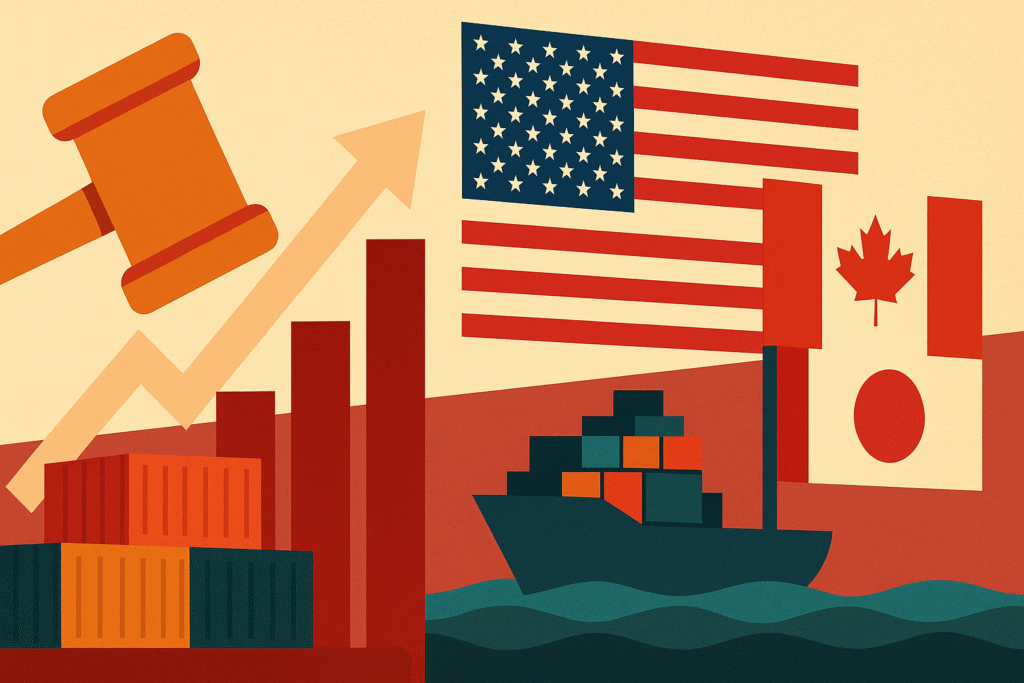President Donald Trump has triggered a new chapter in global trade tensions by imposing broad-based tariffs on dozens of U.S. trading partners while finalizing selective deals with allies like the UK, EU, and Japan. The move, formalized through an executive order on Thursday, marks a significant shift in U.S. trade policy and underscores the administration’s commitment to reshaping the global economic landscape.
Targeted Tariffs on Key U.S. Trade Partners
Under the new regime:
-
Canada will face a steep 35% tariff, despite being a long-standing U.S. ally and major trading partner.
-
India is subject to a 25% tariff.
-
Switzerland faces a 39% levy.
-
Taiwan, the world’s top semiconductor exporter, will incur a 20% tariff.
The executive order states that these measures aim to address the persistent U.S. trade deficit, labeling it an “unusual and extraordinary threat” to national security and the economy. The tariffs are also expected to generate revenue to offset domestic tax cuts — a key pillar of Trump’s economic strategy.
A Shift in Global Trade Philosophy
A senior White House official described the move as a departure from the long-standing focus on economic efficiency in global trade. “We’re transitioning to a model centered on fairness and balanced trade,” the official said, emphasizing that the U.S. will now prioritize reciprocal trading relationships over unregulated access.
Despite the aggressive stance, the new tariff system is considered more moderate than the one initially proposed on “liberation day” in April. However, the overall U.S. tariff rate is now at its highest level in decades, causing significant volatility in global markets.
Economic Repercussions and Global Reactions
The tariff announcement coincided with a weak U.S. jobs report, which intensified investor concerns:
-
The S&P 500 fell by 1.1%, while the Nasdaq dropped 1.3%.
-
The Stoxx Europe 600 slid by 1.6%.
-
Global stocks reacted negatively, reflecting fears of a prolonged trade war and economic slowdown.
In Canada, Prime Minister Mark Carney, elected on a platform to counter Trump’s economic influence, expressed deep disappointment, acknowledging the potential damage to key sectors. Despite eleventh-hour lobbying, Canada failed to reach a resolution with Washington. The U.S. Commerce Secretary criticized Carney’s recognition of Palestinian statehood, suggesting it further strained bilateral negotiations.
Trade Deal Deadlines and Exemptions
Trump set August 1 as the deadline for countries to secure trade deals or face heightened tariffs. While the UK, EU, and Japan met this deadline, others—including China—have until August 12 to strike agreements.
Notably:
-
Countries with large trade surpluses with the U.S. will face tariffs as high as 39%.
-
Nations with balanced trade or net imports from the U.S. will be subject to lower tariffs (10-15%).
-
Exemptions remain in place for goods complying with the 2020 USMCA (North America trade deal).
Taiwan’s President Lai Ching-te labeled the new tariffs “temporary” and voiced hope that ongoing dialogue could lead to reductions.
A New Global Trade Order?
While critics argue the move risks isolating the U.S. economically, the Trump administration sees it as a long-overdue correction of an imbalanced system. The tariffs reflect an effort to realign global trade with America’s strategic interests, even at the cost of diplomatic tensions.
As implementation begins next week, global observers and markets alike will be watching how the world’s largest economy navigates this bold recalibration of its trade policy — and how partners respond.



